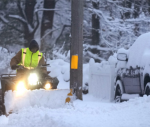You are here
India passes 300,000 COVID-19 deaths as 'black fungus' spreads
By AFP - May 25,2021 - Last updated at May 25,2021

Family members and relatives wearing protective gear stand next to the funeral pyre of a Covid-19 coronavirus victim at a crematorium in New Delhi on Monday, as India passed more than 300,000 deaths from coronavirus pandemic (AFP photo)
NEW DELHI/ GENEVA — India passed 300,000 confirmed coronavirus deaths on Monday, fatalities remaining high despite the country flattening out the number of new cases in its devastating pandemic wave.
It became the third country — after the United States and Brazil — to cross 300,000 deaths.
For several weeks the country of 1.3 billion has been hitting record daily rises in infections and fatalities, that have overwhelmed its healthcare system.
While the crisis has eased in major cities such as New Delhi and Mumbai, the coronavirus is still spreading in rural areas and southern states.
Another 4,454 deaths in 24 hours — the second-highest daily figure so far — took India's toll to 303,720. It has added the last 50,000 deaths in under two weeks, according to government figures. Experts said the real numbers of deaths and infections, now 26.7 million, were probably much higher than the official figures.
"Deaths always will lag cases... People who have been diagnosed with infection now will go into hospital, and then a small number of them will die but that will be later," Ashoka University biology professor Gautam Menon told AFP Monday.
The brutal wave has been accompanied by the emergence among coronavirus patients of thousands of cases of the usually rare infection mucormycosis, or "black fungus".
The government has given figures between 5,424 and 8,848 for the number across India. Normally it records fewer than 20 cases a year.
Doctors say one of the reasons behind the explosion in “black fungus” infections has been excessive use of steroids on virus patients.
Health Minister Harsh Vardhan said imports of the main anti-fungal drug, amphotericin B, had started to arrive in the country amid a severe shortage.
Death toll ‘undercounted’
The coronavirus wave has brought India’s hospital system to its knees with severe shortages of oxygen and critical drugs.
The government has been criticised for its response as long queues formed for funerals at crematoriums and cemeteries. Images of suspected COVID-19 dead floating in the holy Ganges river or buried in shallow graves have only added to the controversy.
“We are seeing the bodies along the river Ganges which don’t seem to be recorded as COVID deaths but are very likely to be COVID deaths,” Menon said.
Experts have warned that religious festivals and packed state election rallies held earlier in the year could have led to virus “superspreader” events.
There were also concerns that the B.1.617 variant, first detected in India last year, has contributed to the surge.
Vardhan said the variant accounted for some 20 per cent of just under 26,000 samples from positive COVID-19 tests that have been genetically sequenced.
As part of its efforts to combat the pandemic, India has administered just over 196 million COVID-19 vaccination shots since mid-January.
But experts say the mass inoculation programme needs to be significantly stepped up.
The country, home to the world’s largest vaccine maker, has halted exports of vaccines to meet local demand.
Meanwhile, WHO chief said on Monday that at least 115,000 health and care workers have died from COVID-19 since the beginning of the pandemic, calling for a dramatic scale-up of vaccination in all countries.
At the opening of the World Health Organisation’s (WHO) main annual assembly, Director General Tedros Adhanom Ghebreyesus hailed the sacrifices made by health workers around the world to battle the pandemic.
“For almost 18 months, health and care workers all over the world have stood in the breach between life and death,” he said.
“They have saved countless lives and fought for others who, despite their best efforts, slipped away.”
“Many have themselves become infected, and while reporting is scant, we estimate that at least 115,000 health and care workers have paid the ultimate price in the service of others.”
He said many health workers have since the start of the crisis felt “frustrated, helpless and unprotected, with a lack of access to personal protective equipment and vaccines”.
And they are not alone. He described the overall inequity in access to vaccines as “scandalous”, warning it was “perpetuating the pandemic”.
More than 75 per cent of all COVID-19 vaccines have gone to just 10 countries.
“The number of doses administered globally so far would have been enough to cover all health workers and older people if they had been distributed equitably,” he said.
“There is no diplomatic way to say it: That small group of countries that make and buy the majority of the world’s vaccines control the fate of the rest of the world.”
He urged those countries that have large stocks of vaccines to share them, and greater cooperation to scale up production and distribution of the jabs.
The WHO and others have created Covax, a global vaccine-sharing programme, but it remains severely underfunded and has faced significant supply shortages, delaying efforts to roll out jabs in poorer countries.
“We have shipped every single one of the 72 million doses we have been able to get our hands on so far to 125 countries and economies,” Tedros said.
The WHO chief stressed the need to urgently fix the imbalance.
“Today, I’m calling on member states to support a massive push to vaccinate at least 10 per cent of the population of every country by September,” he said, calling for the coverage to be expanded to 30 per cent by the end of the year.
Related Articles
PARIS — Health officials have rolled out more than 510 million coronavirus vaccine doses around the world, but with big gaps between countri
PARIS — The total number of COVID-19 cases registered worldwide passed 300 million on Friday, with the Omicron variant's rapid spread settin
AMMAN — The Jordanian National Centre for Epidemics and Communicable Diseases Control (JCDC) on Sunday recommended the inclusion of the “Can
















